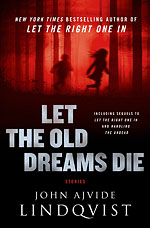
 BUY FROM AMAZON: CLICK HERE!
BUY FROM AMAZON: CLICK HERE!
AUTHOR John Ajvide Lindqvist
MSRP $27.99
PUBLISHER Macmillan
LENGTH 400 Pages
A middle-aged man fears that his apartment building is beginning to lean, for reasons unknown. A young husband wants to bargain with death. A paparazzo gets more than he bargained for after snapping the perfect shot. A young boy spends a terrifying night in the woods. Stockholm learns to handle the undead. A vampire girl and her devoted friend make a future for themselves.
These are just a sampling of the stories you’ll find in Let the Old Dreams Die, a collection of chilling short stories from Swedish author John Ajvide Lindqvist. Originally published in 2006 under the title Pappersväggar (Paper Walls), this English translation by Ebba Segerberg also includes two stories that function as epilogue to the author’s Let the Right One In and Handling the Undead, respectively.
Many have compared Lindqvist to Stephen King, and it’s easy to see why. Like King, Lindqvist’s ideas about horror are unique. His stories feature scenarios most readers won’t have encountered before. You could say that Let the Right One In is just a vampire story, but if you’ve read the terrific novel or seen the impressive film adaptations, you know that it’s not just any vampire story.
Lindqvist’s particular flavor of horror isn’t just to give the reader a chill, or make them gnaw their nails in suspense. His stories deftly probe our brains, unearthing forgotten, suppressed fears. The first story in the collection, The Border, doesn’t appear to be a horror story, at least on the surface. The story evokes the most disturbing aspects of puberty, twisting the first tentative stirrings of lust. It reminds us of our own virginal fears and desires of penetration. It’s a hell of a way to start a book.
Unlike King’s short stories, Lindqvist tends to hold the horror back, unleashing the scares in the final pages. It’s an effective technique, particularly on the shorter stories. The clear standout of the shorter tales is Paper Walls, from which the Swedish edition got its name. Of its brief six pages, only the last page delivers the scary stuff. Holy shit, does it deliver.
Lindvist has an uncanny ability to locate untapped sources of narrative tension and conflict, which aids in creating his remarkable narratives. He often mixes internal and external conflicts, crafting complex stories and unforgettable characters. In the vaguely Lovecraftian A Village in the Sky, the tension is derived from the richly detailed protagonist, Joel, noticing that his apartment building appears to be leaning. But this isn’t a story about a man versus his apartment building. Joel’s own internal conflict is used as a misdirect, and much like an audience before a master illusionist, we are shocked to see the final outcome.
A Village in the Sky takes place in the same canon as Let the Right One In, establishing a universe, much like Stephen King’s heavily interconnected oeuvre. The Sweden I read about in Let The Old Dreams Die feels like a very real place, often revisiting familiar locations like Stockholm’s suburbs or the coastal towns to the East. The adjacent sea is a frequent element in Lindqvist’s work, and it’s often represented as a menacing force. Lindqvist’s father was taken by the sea, and in Eternal/Love, the author grapples with the idea of cheating death by drowning. It’s a heartbreaking and disturbing story, and I sensed Lindqvist’s raw proximity to it.
For many readers (myself included), the selling point of this book is the title story: an epilogue to Let the Right One In. Twenty-eight years have passed since the murders at the swimming pool, and the events are told through the perspective of a Blackeburg subway station worker. Two of his best friends are an older, female police officer who investigated the “vampire” murders, and her loving husband who saw Oskar and Eli after they fled Blackeburg. The story serves as a beautiful embellishment, but not a direct sequel. I won’t tell you any more, except for that I wasn’t disappointed.
While most of this collection is absolutely top-notch, several of the stories left me scratching my head. In particular, To Put My Arms Around You, To Music, is told entirely through some very incoherent dialogue. It’s a riddle to figure out, and it doesn’t help that Ebba Segerberg’s translation is a bit rough in places throughout the book. Despite these few challenging stories, Let The Old Dreams Die is a shining example of why horror works so well in short form. It’s a damn shame it took so long to get published in the US. This is a refined collection of true horror, with a great deal of class. Consider Lindqvist to be one of horror’s heavy hitters.
Rating: 




Out of a Possible 5 Stars